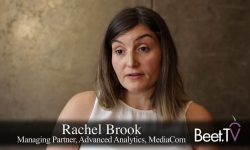When is good enough not good enough? For Brian West, it describes the current state of measuring viewing audiences on mobile and connected-television devices.
“There still is this tendency to prioritize measurement on desktop and kind of treat mobile and connected TV as also-rans in the measurement space,” says West, who is Director, Multiplatform Research, Disney-ABC Television Group.
The situation is acute given the amount of video consumption happening on both mobile and connected TV’s.
“We really need our measurement partners to find a way to bring their mobile and connected TV capabilities up to par with some of the more mature solutions they’ve developed for desktop based measurement,” West opines in this video with Beet.TV. “Because we’re at a point where this is the area where our growth is and we are no longer in a position where good enough measurement on mobile and connected TV is good enough for us.”
This is the main reason why ABC is calling for platform-agnostic measurement. He draws a distinction between the situation several years ago—when desktop “was basically platform-agnostic” and there were two major mobile operating systems—and now.
“But when you look at connected TV, if we began to do a platform-by-platform measurement solution, it’s going to take us a decade to get to a point where we have complete measurement,” West says.
Moving much faster “means piecing together data that is maybe tag-based, or possibly server- based, that’s calibrated against different types of demographic sources or other audience information sources,” he says.
ABC has research that provides an impetus for speeding things up in the form of the study it commissioned by Accenture that looked at spending by 20 different advertisers and ROI across media.
“It’s really essential that we define the groupings that we’re looking at a little bit differently,” West says. “We didn’t want to take this traditional TV definition and call TV everything that’s in a Nielsen C3 rating.”
One of the key takeaways of the Accenture study is that it’s typical for digital to get over-credited for advertising ROI and for TV to get under-credited.
West cites the halo effect of combining multi-platform TV with digital (a results lift of 18%) and the long-term impact of multi-platform, measured by the study as 1.3 times the impact in years two and three as in year one of a campaign.
“So multi-platform TV is able to drive impact for the brand and impact to sales over a longer and more sustained period of time,” says West.
We interviewed West at the Cynopsis Measurement and Data Summit in New York earlier this month.




























